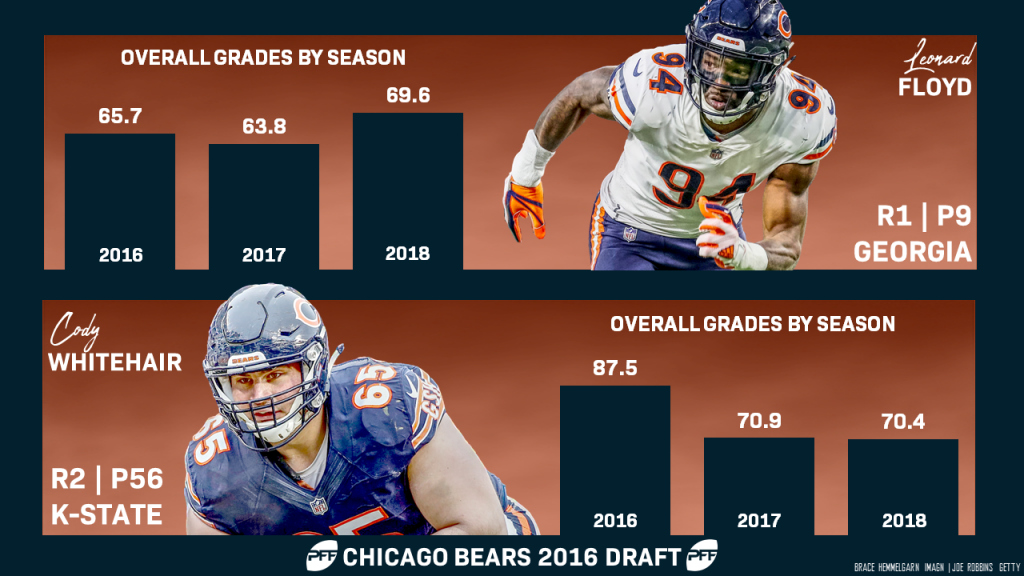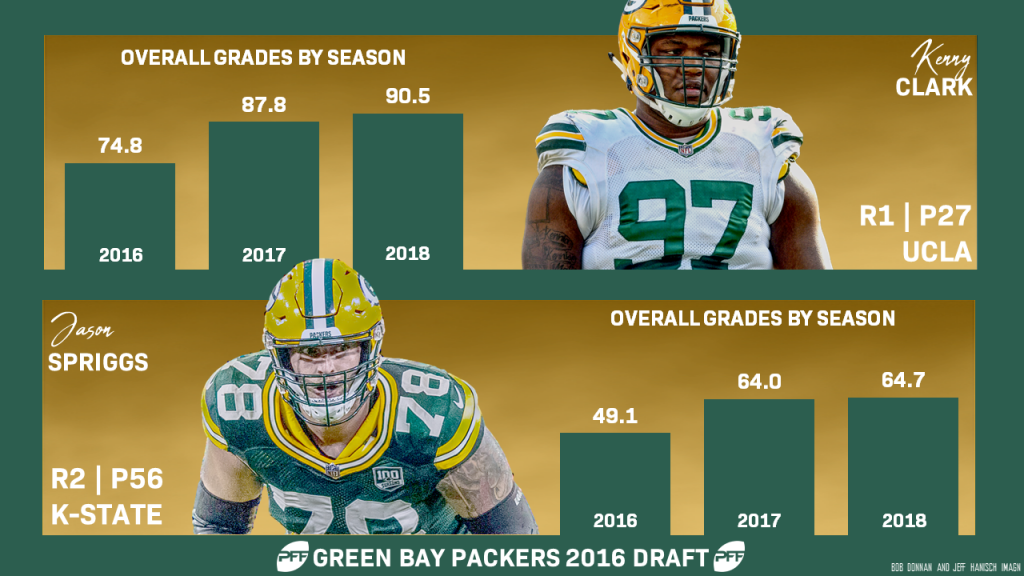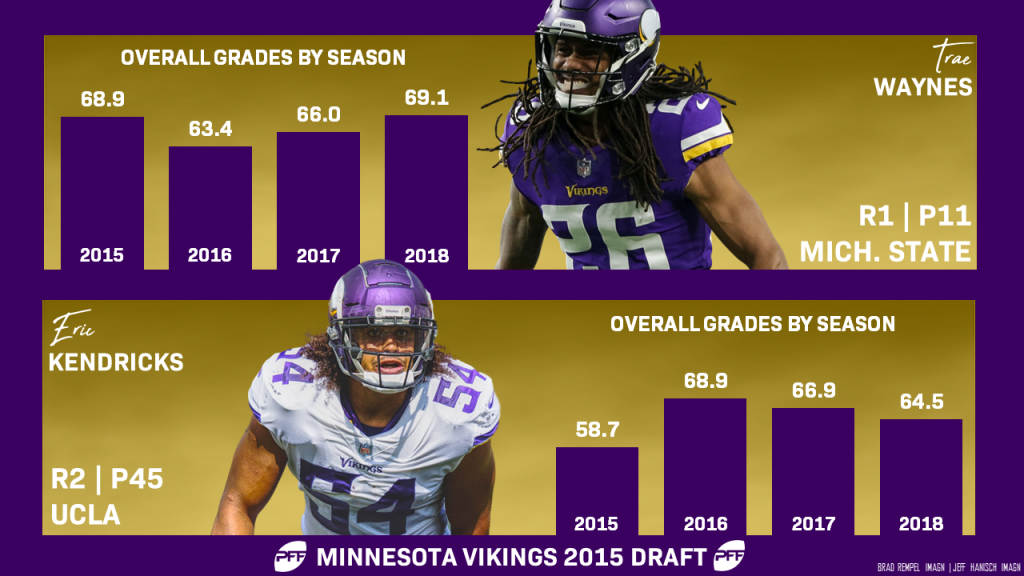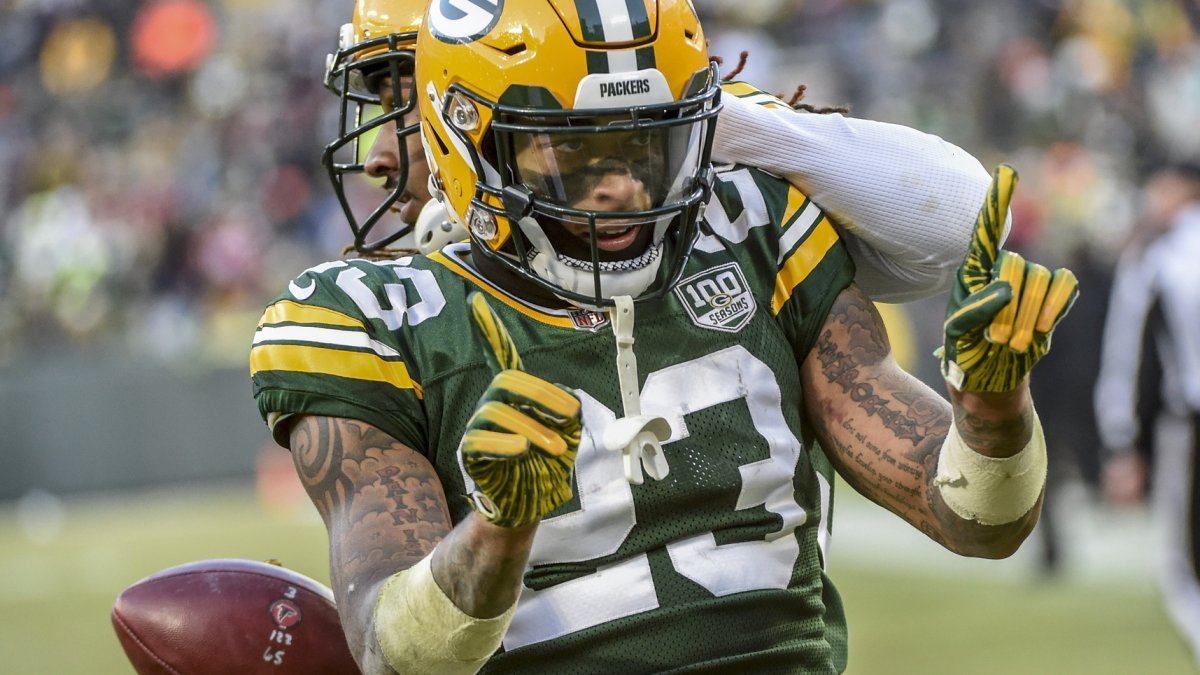The 2019 NFL Draft will be here before we know it but before then, the NFL’s free agency period will open up, and teams will be looking to bolster their lineups with new signees while also looking to keep on board players who have shined bright since their arrival with their franchise. One big thing for the 2019 free agency period is that, for the first time, a rookie class that we had at least a college year of data from, have all now either finished their rookie contract or those select first rounders have had their final year exercised to stay with their team.
With that in mind, we decided to take a look back at some grades and PFF advanced statistics and data for every team’s first- and second-round pick since that 2015 season. While some of these players are no longer with their respective team, the players listed below were all drafted by the team mentioned and the grades and stats represented are just from their time with their drafted team.
Today’s series takes a look at the NFC North.
Chicago Bears
2015
Kevin White, wide receiver
Round 1, Pick 7
Career-high overall grade: 66.0 (2016)
It’s hard to label White’s tenure in Chicago so far as anything other than a disappointment. He missed the entirety of his first season in 2015 and has played just 409 snaps in the three seasons since due to a growing list of injuries. In total, he has caught 25 of 46 targets for just 285 receiving yards and a passer rating when targeted of 64.1. The former top-10 selection will hope to stay healthy and turn his career around elsewhere in 2019.
Eddie Goldman, interior defensive lineman
Round 2, Pick 39
Career-high overall grade: 89.2 (2018)
When the Bears gave their 24-year-old run-stuffing interior defensive lineman a big-time contract extension prior to the season, it caught some people off-guard. Prior to this year, Goldman had been solid but not outstanding with season grades ranging from 65.2 to 75.9. He elevated his game to a new level this past season, though, ranking 12th among 112 qualifiers at the position in overall grade. He excelled in run defense, ranking among the top-10 interior defensive linemen in both run-defense grade (90.4) and run-stop percentage (11.6%).
2016

Leonard Floyd, edge defender
Round 1, Pick 9
Career-high overall grade: 69.6 (2018)
One of the concerns with Floyd coming into the NFL was that he won a lot purely on athleticism rather than winning with a refined pass-rushing skillset. That athleticism hasn’t translated to the same level of success against NFL tackles as it did in his time with Georgia. Since entering the league in 2016, Floyd has generated 111 pressures on 956 pass-rushing snaps. His pressure rate of 11.6% and pass-rush win rate of 12.8% both rank among the bottom half of the 85 pass rushers with 500 or more pass-rushing snaps over that span. He is coming off the highest-graded season of his career in 2018, however, that came largely on the back of a 78.0 run defense grade.
Cody Whitehair, center
Round 2, Pick 56
Career-high overall grade: 87.5 (2016)
Whitehair has been a fixture on the Bears' offensive line since his selection in the second round of the 2016 draft, playing 900 or more snaps each year. He came out of the gates very strong – his 87.5 grade as a rookie ranked behind only Alex Mack and Matt Paradis among all centers. Though he hasn’t quite lived up to that level of play in the two years since, he has finished with a grade above 70.0 that has been good enough for the upper half of the position.
2017
Mitchell Trubisky, quarterback
Round 1, Pick 2
Career-high overall grade: 66.4 (2017)
Any time you trade up and take a quarterback at the top of the draft, the move will be scrutinized. On the surface, the move appears to have paid off; in just his second season, Trubisky completed 66.6% of his passes (13th) and recorded a passer rating of 95.4 (15th) to go along with 320 rushing yards on scrambles (3rd). What those surface statistics don’t show is that Trubisky’s passer rating was helped by routine throws such as screens (115.1 rating – 3rd in the league) and that he ranked 30th in the NFL in accuracy rate based on PFF ball location data. While the Bears can continue to put him in good situations to succeed with scheme and playmakers around him, Trubisky will need to elevate his own play to take them to the next level.
Adam Shaheen, tight end
Round 2, Pick 45
Career-high overall grade: 72.2 (2017)
Shaheen has seen limited opportunity on the field over his first two seasons, playing just over 200 snaps each of his first two seasons. He showed promise as a receiver in his rookie season with eight of his 12 receptions going for first downs to match a 144.0 passer rating when targeted, but that came on just 66 routes run. After returning from the Injured Reserve list this past season, Shaheen ran only 51 routes and caught five passes for 48 yards in the regular season. The 6’5” 270-pound tight end dubbed “Baby Gronk” will look for more opportunities to live up to the nickname in 2019.
2018
Roquan Smith, linebacker
Round 1, Pick 8
Career-high overall grade: 67.4 (2018)
The Georgia linebacker joined the Bears coming off a tremendous college career in which he notched 90.0-plus elite grades in both 2016 and 2017. Smith didn’t quite see that level of success immediately at the NFL level, but he did turn in a productive rookie campaign with over 100 tackles and 12 quarterback pressures. He was strongest in coverage, where his 72.7 coverage grade was significantly higher than his 53.8 run-defense grade. In a league that is continuously trending to the pass, that isn’t necessarily the worst thing for the Bears' defense.
James Daniels, guard
Round 2, Pick 39
Career-high overall grade: 63.6 (2018)
Daniels saw his first regular season action in Week 4 but did not receive his first start at left guard for an injured Eric Kush until Week 8. On the season, he ranked 10th among 35 qualifying left guards in overall grade – a strong start for the rookie. In total, Daniels allowed 23 pressures on 479 pass-blocking snaps.
Anthony Miller, wide receiver
Round 2, Pick 51
Career-high overall grade: 60.6 (2018)
Miller mostly manned the slot in his rookie season, an area where he excelled at Memphis with 3.43 slot yards per route run (sixth in the nation). For the Bears, Miller ran 68.7% of his routes from the slot where he caught 26 passes for 350 yards and 1.41 yards per route run. He showed a knack for the end zone with seven touchdowns on his 33 receptions, but Miller paired that with four drops on 37 catchable passes. That drop rate of 10.8% ranked worst among wide receivers on the team.
Green Bay Packers
2015
Damarious Randall, safety
Round 1, Pick 30
Career-high overall grade: 62.7 (2017)
Randall is one of the few players on this list that has already moved on to a new team and played a season elsewhere after being traded to the Cleveland Browns. He was never able to consistently produce for the Packers, earning grades below 65.0 in each of his first three seasons. It seems as if the change of scenery (and position) has done well for Randall, though. He picked up an overall grade of 72.7 in his first season with the Browns while allowing a passer rating of just 68.8 into his coverage.
Quinten Rollins, cornerback
Round 2, Pick 62
Career-high overall grade: 78.6 (2015)
Rollins makes it 0-for-2 on early-round secondary selections remaining on the Packers' roster from the 2015 draft. Unlike Randall, however, Rollins is currently a free agent after not playing any defensive snaps in the 2018 season. He struggled with injuries and inconsistent play early in his career, never replicating the promising 78.6 overall grade from his rookie campaign.
2016

Kenny Clark, interior defensive lineman
Round 1, Pick 27
Career-high overall grade: 90.5 (2018)
Clark has improved his game each season, raising his grade from 74.8 in 2016 to 87.8 in 2017 and 90.5 last season. Not only does he stand out as a great selection by the Packers late in the first round, but he has developed into one of the best young defenders in the NFL. Last season, Clark finished among the top-10 interior defensive linemen in run-stop percentage (9.9%) and pass-rush productivity (6.8). He has shown the ability to impact the game in multiple areas.
Jason Spriggs, tackle
Round 2, Pick 48
Career-high overall grade: 64.7 (2018)
Spriggs hasn’t emerged as anything other than a reserve tackle for the Packers through the first three seasons of his career, but that isn’t something to be ashamed of when operating behind David Bakhtiari and Bryan Bulaga. He has played between 270 and 300 snaps in all three years while his overall grade has hovered around the mid-60’s in each of the past two seasons. Spriggs has shown himself to be a serviceable albeit uninspiring backup option at tackle should either of the starters go down.
2017
Kevin King, cornerback
Round 2, Pick 33
Career-high overall grade: 59.7 (2018)
Harkening back to the 2015 draft, the string of secondary disappointments continues with King; each of his first two seasons ended on Injured Reserve. Even when he has seen the field, King hasn’t been able to display the same sort of playmaking ability that he did in his final season at Washington, in which he allowed a completion percentage of just 50.0 percent and a passer rating of 55.6 into his coverage. Across 685 NFL coverage snaps, King has allowed a passer rating of 96.5 while failing to record a season grade greater than 60.0.
Josh Jones, safety
Round 2, Pick 61
Career-high overall grade: 61.7 (2018)
A theme over the early rounds of the past few drafts continues for the Packers – taking early shots at secondary players. Jones struggled as a rookie with an overall grade of just 54.0, which was hurt primarily by his coverage ability, allowing 77.4% of passes into his coverage to be completed for a passer rating of 98.2. In Year 2, his grade jumped to 61.7, and the Packers will hope that trend continues if given another chance next year.
2018
Jaire Alexander, cornerback
Round 1, Pick 18
Career-high overall grade: 72.4 (2018)
Another first-round pick, another cornerback for Green Bay. Among many misses in the secondary, Alexander appears to be a hit after a rookie season in which his grade of 72.4 ranked third among 14 qualifying rookie cornerbacks. The upside that he possesses was at the forefront in their Week 8 matchup with the Los Angeles Rams; in that game, Alexander was targeted nine times and broke up five passes.
Josh Jackson, cornerback
Round 2, Pick 45
Career-high overall grade: 60.4 (2018)
Jackson was considered a draft steal among many given his excellent play at Iowa in 2017 where he recorded a 93.2 overall grade. That didn’t immediately translate to the NFL, though, as Jackson ranked 13th among 14 qualifying rookie cornerbacks in overall grade at 60.4. He allowed 44 of 66 passes targeting him to be caught for 552 yards and four touchdowns, but he did pair that with 11 pass breakups. If he can get back towards the level of play that he exhibited in his final season at Iowa, the Packers may have found their cornerbacks of the future in him and Alexander.
Detroit Lions
2015
Laken Tomlinson, guard
Round 1, Pick 28
Career-high overall grade: 68.9 (2015)
Tomlinson only played two seasons for the Lions before being traded to the San Francisco 49ers for a fifth-round selection – not exactly the return on investment a team is looking for on their first rounder. In his four seasons in the NFL, his best overall grade came in his rookie season at 68.9. He has been a solid starter in San Francisco since the trade, picking up grades of 66.4 and 64.2 in the last two seasons which ranked among the top 50 percent of left guards.
Ameer Abdullah, running back
Round 2, Pick 54
Career-high overall grade: 63.6 (2016)
Like Tomlinson, Abdullah is no longer a member of the Lions after a disappointing start to his career. He showed some promise his rookie season, particularly as a receiver, where he picked up a 77.3 receiving grade behind seven forced missed tackles on 25 receptions. Abdullah was never able to earn a significant role on the offense, though. His career high in snaps came in 2017 when he played 379 – the season that saw his lowest career grade (53.5).
2016

Taylor Decker, tackle
Round 1, Pick 16
Career-high overall grade: 81.9 (2016)
Outside of a shoulder injury that kept him sidelined for half of the 2017 season, Decker has been a fixture on the Lions' offensive line since being drafted in 2016. As a rookie, he jumped out of the gates with an 81.9 overall grade that ranked 13th among 37 qualifying left tackles. His last two seasons haven’t met that mark in large part due to his run-blocking grade which has dipped below 60.0 each of the past two seasons. Last season, Decker allowed 37 pressures on 617 pass-blocking snaps.
A’Shawn Robinson, interior defensive linemen
Round 2, Pick 46
Career-high overall grade: 89.9 (2018)
Robinson didn’t have an every-down role on the Lions' defense in 2018 – playing only 415 defensive snaps – but he made those snaps count, particularly as a run defender. Robinson picked up a run-defense grade of 91.5 this past season (5th among interior defenders) and a run-stop percentage of 11.2 percent, which also was among the top-10 interior defensive linemen with at least 100 run-defense snaps. That resulted in a spike in his overall grade from 66.7 in 2017 to 89.9 in 2018.
2017
Jarrad Davis, Linebacker
Round 1, Pick 21
Career-high overall grade: 52.8 (2017)
Davis has shown flashes of the first-round talent that the Lions drafted him for, such as his Week 7 performance against the Dolphins this year, but in all, the young linebacker has struggled at the NFL level. Davis has yet to post a season grade higher than 55.0, and it’s been all facets of the game that have contributed. Davis has missed 36 tackles over the last two years while allowing nearly 80.0 percent of the passes targeting him to be completed for a passer rating of 106.8. Last season, his run-defense grade of 33.7 was third-worst among 92 qualifying linebackers.
Teez Tabor, cornerback
Round 2, Pick 53
Career-high overall grade: 61.5 (2017)
Despite his second-round draft slot, Tabor has played just 466 defensive snaps for the Lions over his first two seasons, and there are question marks about how many more he will receive. The majority of those snaps (276) came last year, where he recorded an overall grade of just 32.2. Tabor didn’t play enough snaps to qualify, but if he did, that would have been the lowest grade for a cornerback by nearly 7.0 points. Tabor allowed a perfect 158.3 passer rating into his coverage in 2015 while picking up five penalties as well.
2018
Frank Ragnow, guard
Round 1, Pick 20
Career-high overall grade: 61.9 (2018)
Ragnow came into the NFL with a strong college pedigree of success at Arkansas – fresh off of two elite seasons with grades of 92.3 and 90.3. That production came behind good pass protection and outstanding run blocking. In his first season with Detroit, Ragnow made the switch over from primarily center at Arkansas to guard. He went through some growing pains but still finished the season ranked 18th among 35 qualifying left guards in overall grade. Given his college profile, there is reason to believe that will improve in Year Two.
Kerryon Johnson, running back
Round 2, Pick 43
Career-high overall grade: 81.2 (2018)
There had been a running back drought in Detroit for quite some time prior to 2018; that drought is over with the arrival of Johnson. He finished 13th out of 62 qualifying running backs in overall grade and fourth among rookie running backs behind just Nick Chubb, Saquon Barkley, and Phillip Lindsay. Johnson ran strong after contact, picking up 3.32 yards after contact per attempt, while also showing the ability to break away. 245 of his 641 rushing yards came on runs of 15 or more yards (13th-highest percentage in the NFL).
2015
Trae Waynes, cornerback
Round 1, Pick 11
Career-high overall grade: 69.1 (2018)
After struggling to find the field much in his rookie season, Waynes has played at least 500 defensive snaps each year since 2016. He has improved his overall grade each season to a career-high 69.1 overall grade in 2018. Interestingly, Waynes has been among the top cornerbacks in the league in run defense. His 27 run stops since 2016 are second at the position to only Kareem Jackson. Waynes’ 84.5 run-defense grade this past season ranked among the top-10 at the position.
Eric Kendricks, linebacker
Round 2, Pick 45
Career-high overall grade: 68.9 (2016)
Kendricks has been a reliable starter in his tenure with the Vikings, playing at least 800 snaps in each of his first four seasons. Over the last three seasons, his overall grades have ranged from 64.5 to 68.9 – good enough to place him at right about the league average. It doesn’t look as if he’ll make the jump to be an upper-tier linebacker, but as this list shows, there could be worse second-round selections than a reliable, middle-of-the-road starting linebacker.
2016

Laquon Treadwell, wide receiver
Round 1, Pick 23
Career-high overall grade: 53.3 (2017)
Treadwell has been one of the more disappointing first-round wide receivers taken in the last several years. He has not been able to carve out a major role in the Vikings' offense, and when he has seen the field, Treadwell has not been impactful. He’s averaging just 9.2 yards per reception on 56 career catches, while Vikings quarterbacks have had a passer rating of only 67.4 when targeting him. That is not a recipe for more playing time heading into his fourth season.
Mackensie Alexander, cornerback
Round 2, Pick 54
Career-high overall grade: 78.1 (2018)
After two seasons where Alexander struggled to find a role and fit on the Vikings' defense, the Clemson product broke out last year as a slot cornerback. His 78.1 overall grade was easily the highest of his young career. In all, he allowed 40 receptions for 383 yards and zero touchdowns while breaking up eight passes. If that progression continues next season, Alexander will start to be listed among the top slot cornerbacks in the league.
2017
Dalvin Cook, running back
Round 2, Pick 41
Career-high overall grade: 73.1 (2018)
Injuries have hampered the start to Cook’s career, but when he has been healthy, he has shown the elusiveness that he had at Florida State. In 2016 at Florida State, Cook forced 91 missed tackles on rushes (3rd most since 2014). At the NFL level this year, Cook forced a combined 47 missed tackles on 173 touches. His 3.7 touches per missed tackle forced were the fewest among all running backs with at least 150 touches. Both Cook and the Vikings will be hoping he can put that elusiveness on display for the entirety of the 2019 season.
2018
Mike Hughes, cornerback
Round 1, Pick 30
Career-high overall grade: 61.6 (2018)
A torn ACL cut the rookie season short for the Vikings first-round selection out of UCF, but prior to that Week 6 injury, Hughes picked up an overall grade of 61.6 across 244 defensive snaps both inside at slot corner and at outside cornerback. In his final season at UCF, Hughes allowed just 34 completions while breaking up 10 passes and intercepting another four. The passer rating into his coverage was only 43.8. If he comes back and performs close to that level in a full second season, his goal of Comeback Player of the Year will be in reach.
Brian O’Neill, tackle
Round 2, Pick 62
Career-high overall grade: 63.0 (2018)
It is no secret that the Vikings needed help on the offensive line. They still do, but they appear to have found one serviceable solution in O’Neill. The rookie out of Pittsburgh picked up a grade of 63.0 in 800 snaps in 2018. Most importantly, he did a decent job of keeping Kirk Cousins clean. He allowed pressure on 6.2 percent of his pass-blocking snaps (second-best among nine qualifying rookie tackles), and he did not allow a single sack on 497 pass-blocking snaps.



 © 2024 PFF - all rights reserved.
© 2024 PFF - all rights reserved.